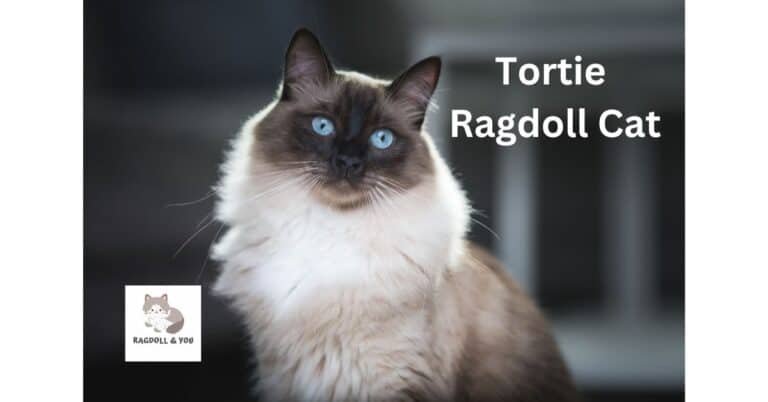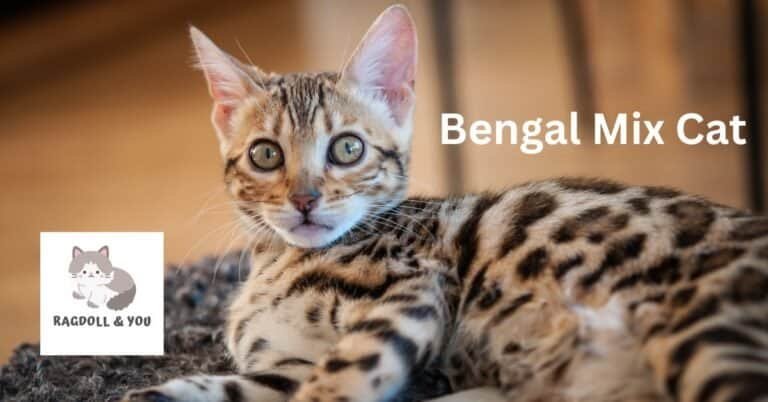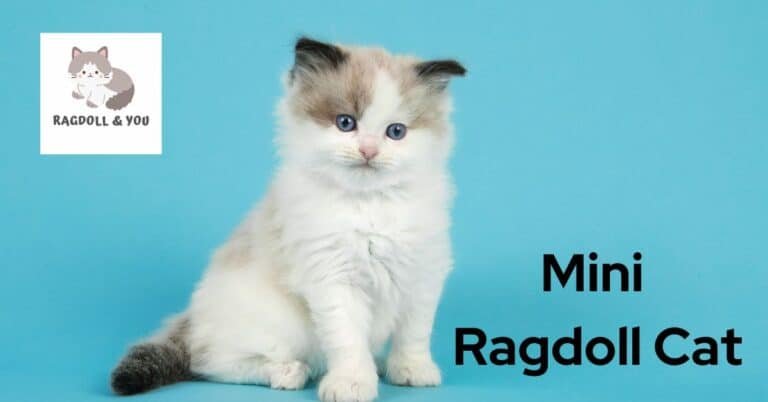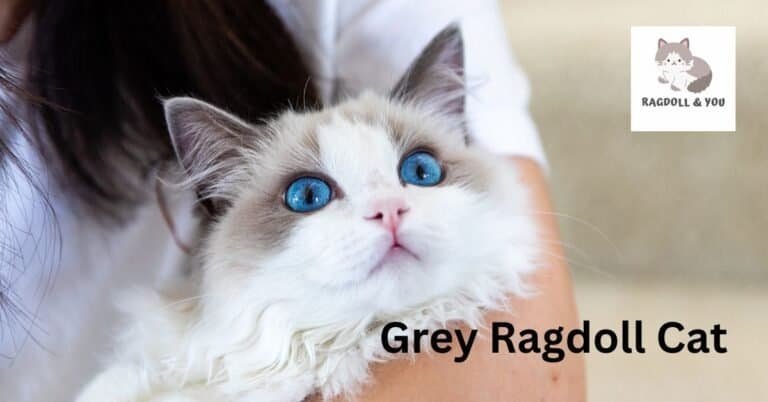Perfect Guide Of The Blue Mitted Ragdoll: A Masterclass
Ever found yourself captivated by the silky fur and piercing blue eyes of a blue mitted Ragdoll cat?
The Blue Mitted Ragdoll is a color variation of the Ragdoll cat breed. It has a blue body color with white paws, chin, and chest.
The blue color is a dilution of the black color, and a recessive gene causes it. Blue Mitted Ragdolls have blue eyes, and they are known for their gentle and affectionate personality.
They are also known for being very relaxed and laid-back cats.
This all-inclusive guide will deliver an in-depth view of their physical attributes, genetic background, grooming requirements, and more.
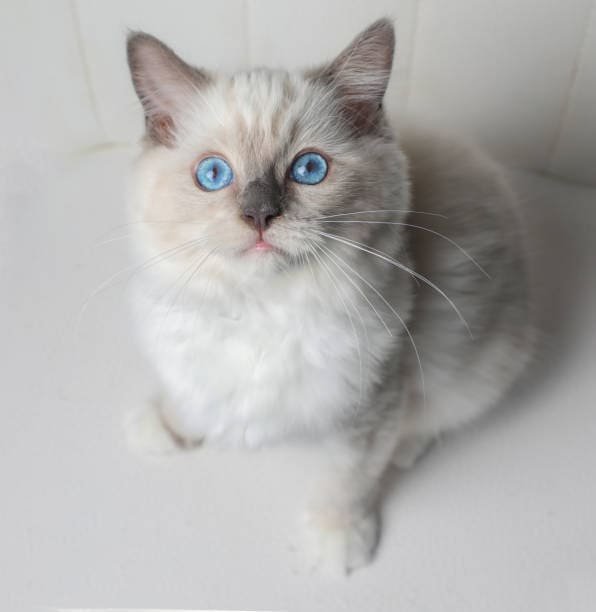
What Does a Blue-Mitted Ragdoll Cat Look Like?
A blue mitted Ragdoll cat has a stunning pattern with its blue coat and white mitts on its front paws.
Blue Mitted Pattern
The blue mitted pattern is a key part of the look for some Ragdoll cats. This cool, gray-blue shade is like the colorpoint style but has something extra.
The front paws have white “gloves,” which stand out against their fur.
It’s one of many things that makes this breed special. Blue mitts also have lynx and tortie styles to keep things interesting!
Characteristics Of Blue-Mitted Ragdolls
Blue mitted Ragdolls are big, tame cats. They have pale grey bodies and slate grey points. Their paws wear bright white mittens, a key feature of their look.
These cats flaunt a high-class coat that feels smooth as silk.
Their eyes catch your gaze with striking blue color. This breed has a nice shape and shows off an easy-going manner.
Blue mitted Ragdolls love to play but enjoy chilling out in quiet spots at home.
Understanding Blue Bicolor Ragdolls
Blue bicolor Ragdolls are cool. They have the same soft coat, bright blue eyes, and calm way as other Ragdoll cats.
But they also have a color pattern that sets them apart. This pattern has white fur on their face, feet, and belly, with grey on the rest of their body.
The grey can be light or dark or somewhere in between. The mix of grey and white gives these cats an eye-catching look.
Not all blue Ragdolls are bicolor, though; some might show other patterns like colorpoint or mitted.
Plus, there’s more! They can come in tortie and lynx variations, too! Blue bicolor ragdolls sure do stand out in the cat world.
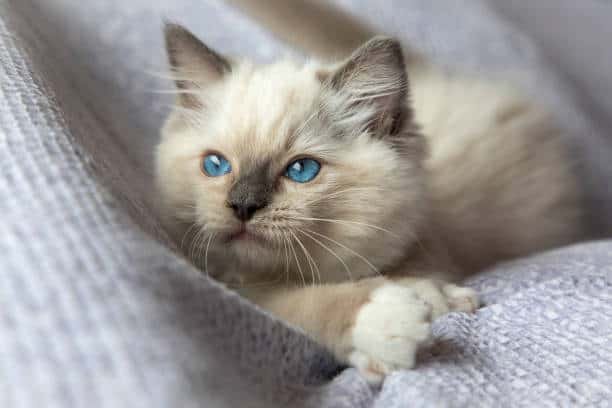
Colorpoint Genes
Colorpoint genes are crucial in determining the colorpoint pattern seen in Ragdoll cats. These genes affect pigment distribution, resulting in specific areas of darker coloration on their bodies.
However, blue-mitted Ragdolls are not considered color points if they have white “gloves” and “booties” on their paws.
The mitted pattern can include various colors like seal, blue, and lynx point.
It’s fascinating how genetics determine the beautiful colors and patterns in Ragdoll cats!
Blue Mitted Ragdoll Genetics
Blue Mitted Ragdoll genetics involves a combination of dilution genes, colorpoint genes, and white spotting genes.
Understanding these genetic factors is crucial for the health and well-being of your blue mitted Ragdoll cat.
Read on to learn more!
Dilution Genes
Regarding the coloration of Blue Mitted Ragdoll cats, dilution genes play an essential role. These genes determine the intensity and shade of the colors seen in their fur.
A Blue Mitted Ragdoll must inherit a copy of the dilution gene from both parents to have their signature coat pattern.
This gene is responsible for diluting the color and creating shades like lilac or blue. Lilac is achieved when two recessive chocolate genes combine to create a total dilution effect.
It’s fascinating how these multiple genes combine to give each Blue Mitted Ragdoll its unique pigmentation.
Colorpoint Genes
Colorpoint genes play a significant role in the genetics of Blue Mitted Ragdolls. These genes determine the cat’s coat color and pattern.
Specifically, Ragdolls have recessive genes for blue eyes, which result in their striking eye color.
These genes also influence the intersections of different colors and patterns in their fur.
Breeders specializing in Ragdolls provide valuable information about the genetics involved, helping maintain and improve desirable traits in this beautiful breed.
White Spotting Genes
The white spotting genes play a big role in the appearance of blue mitted Ragdolls. These genes are responsible for the unique markings and patterns on their coats.
These genes’ presence creates white areas, such as mittens on their paws.
It’s interesting to note that the white spotting gene is dominant, which means even if a cat only has one copy of the gene, it will still have some white markings.
However, having two copies of the gene will result in more extensive white areas on the coat.
These genes contribute to the distinctive look of blue-mitted Ragdolls and make them stand out among other cats.
Health Issues Related To Genetics
Genetics can affect the health of Blue Mitted Ragdoll cats. One common issue is hypertrophic cardiomyopathy, a heart condition that affects around 30% of Ragdolls.
This genetic mutation increases the risk of heart problems in these cats.
Obesity is another concern for Ragdolls, so monitoring their weight and providing them with a balanced diet is essential.
By understanding the genetics behind these health issues, we can better care for our beloved Blue Mitted Ragdolls and keep them healthy and happy.
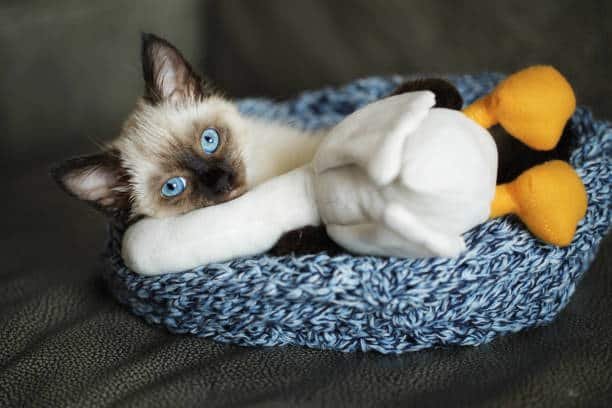
Grooming and Care for a Blue-Mitted Ragdoll
Grooming and care for a blue mitted Ragdoll cat involves regular coat maintenance, including bathing and brushing, nail care, dental hygiene, and essential health considerations.
Coat maintenance
Keeping a Blue Mitted Ragdoll’s coat in good shape is vital for their overall health and appearance. Here are some tips for coat maintenance:
Regular Grooming:
Like all Ragdolls, Blue Mitted Ragdolls benefit from regular grooming sessions. This helps to remove loose hair and prevent matting. Set aside time each week to groom your cat.
Brushing:
Use a brush suitable for your cat’s coat type. For Blue Mitted Ragdolls, a medium-toothed comb or slicker brush works well. Gently brush through their fur, paying attention to any tangles or mats.
Bathing:
While Blue Mitted Ragdolls may not require frequent baths, giving them an occasional bath to keep their coat clean and healthy.
Use a mild cat shampoo, and make sure to rinse thoroughly.
Nail Care:
Regularly trim your cat’s nails to prevent them from becoming too long or sharp.
Provide a scratching post or other appropriate surfaces for them to scratch on, which can also help keep their nails in good condition.
Dental Hygiene:
Good oral hygiene is vital for your cat’s health. Brushing their teeth regularly with a pet toothbrush and toothpaste can help prevent dental issues such as gum disease.
Health Considerations:
Watch for changes in your Blue Mitted Ragdoll’s coat condition, such as excessive shedding, bald patches, or skin irritations. These could be signs of underlying health problems and should be addressed by a veterinarian.
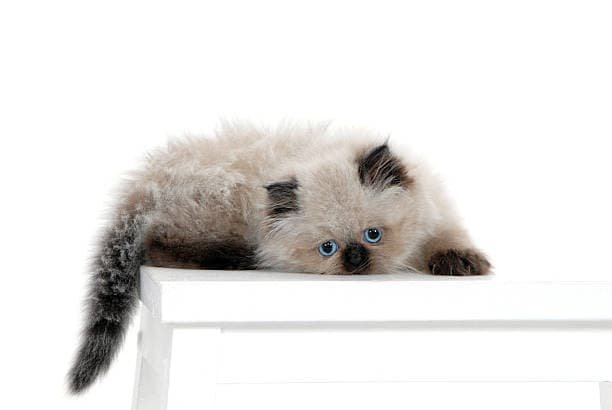
Bathing and brushing
When it comes to grooming and care for a Blue Mitted Ragdoll, there are a few things to keep in mind. Here are some essential tips:
Brushing:
Regular brushing is essential for keeping your Blue Mitted Ragdoll’s coat healthy and free from mats. Brush them at least once a week to prevent tangles and matted fur.
Bathing:
Blue Mitted Ragdolls generally only need frequent baths if they get dirty or greasy. Only bathe them when necessary, using a cat-safe shampoo and warm water.
Remember not to wet your head or ears during the bath.
Coat Maintenance:
Besides brushing, you should also pay attention to other aspects of coat maintenance. Trim their nails regularly to avoid scratching, and ensure proper dental hygiene by brushing their teeth with cat-friendly toothpaste.
Health Considerations:
While grooming, check for any signs of skin issues, parasites, or abnormalities. If you notice anything unusual, consult a veterinarian for appropriate treatment.

Nail Care And Dental Hygiene
Caring for a blue mitted Ragdoll’s nails and dental hygiene is crucial for their overall health and well-being. Here are some essential tips to keep in mind:
Regular Nail Trimming:
Trim your cat’s nails once or every two months to prevent them from becoming too long and causing discomfort or injuries. Use a cat-specific nail clipper, and be careful not to cut into the quick, sensitive part inside the nail.
Good Dental Care:
Just like humans, cats can develop dental issues, so taking care of their oral health is essential. You can introduce regular tooth brushing using a cat-friendly toothbrush and toothpaste.
Start gradually and make it a positive experience for your cat by rewarding them with treats or praise.
Professional Cleanings:
Along with at-home dental care, regular check-ups with your veterinarian are essential. They can perform professional cleaning to remove tartar buildup and check for underlying dental problems.
Watch For Signs Of Dental Issues:
Keep an eye out for signs of dental problems such as bad breath, red or swollen gums, difficulty eating or chewing, loose teeth, or excessive drooling.
If you notice these signs, consult your vet for further evaluation and treatment.
Maintain Good Overall Hygiene:
Besides nail care and dental hygiene, maintaining good overall cleanliness is vital for your blue-mitted Ragdoll’s well-being.
This includes regularly cleaning their ears (once a month or every two months) using a gentle ear cleaner specifically formulated for cats.
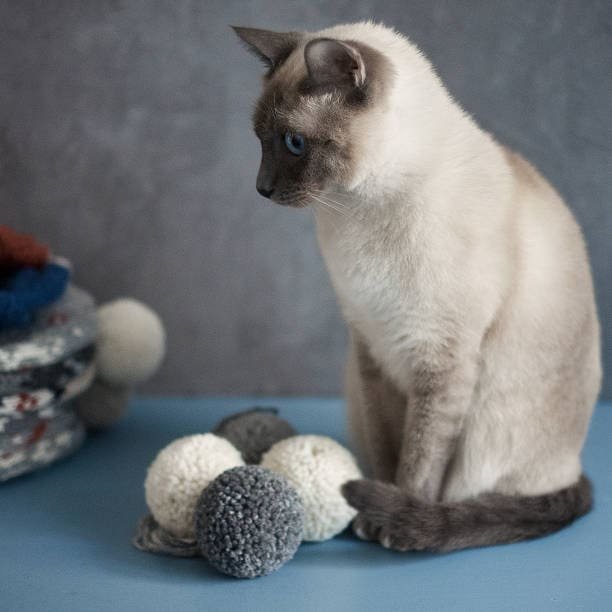
Health considerations
Taking care of the health of your Blue Mitted Ragdoll is essential. Regular grooming plays a significant role in maintaining their overall well-being.
Neglecting grooming can lead to fur matting, which can be uncomfortable for your cat and may even cause skin problems.
Establish a regular brushing routine to prevent tangles and ensure proper combing to keep their coat in top condition.
This will help maintain the softness and shine of their fur, resulting in a healthier and happier Blue Mitted Ragdoll.
Incorporating nail care and dental hygiene into their grooming routine is vital for their overall health. By staying on top of these health considerations, you’ll be helping your Blue Mitted Ragdoll thrive inside and out!
Conclusion
In conclusion, the blue mitted Ragdoll is a special and distinctive breed with its unique pattern and beautiful blue eyes. Understanding their genetics, grooming, and care needs will ensure they stay healthy and happy.
With their affectionate and playful nature, owning a blue mitted Ragdoll can be a delightful experience for any cat lover.
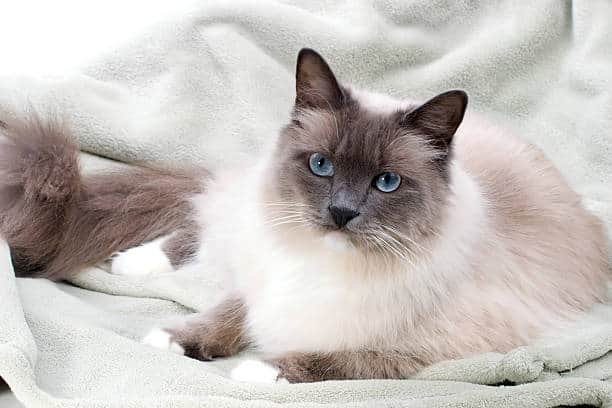
FAQs
1. What Is A Blue Mitted Ragdoll?
A blue-mitted ragdoll is a specific color and pattern variation of the popular Ragdoll breed of cats.
2. How Big Do Blue Mitted Ragdolls Get?
Blue-mitted ragdolls are known for their large size, with males typically reaching 12-20 pounds and females weighing around 10-15 pounds when fully grown.
3. Are Blue Mitted Ragdolls Good Pets?
Yes, blue-mitted ragdolls make excellent pets. They are known for their friendly and docile nature, often enjoying spending time with their owners and being held or cuddled.
4. Do Blue Mitted Ragdolls Require Special Grooming?
While they have semi-long hair, blue-mitted ragdolls have low-maintenance coats that only require regular brushing to prevent matting and occasional bathing as needed.
5. Can I Keep A Blue Mitted Ragdoll In An Apartment Or Small Living Space?
Blue-mitted ragdolls can adapt well to apartments or small living spaces as long as they have enough room to move around comfortably and receive mental stimulation through playtime activities.



